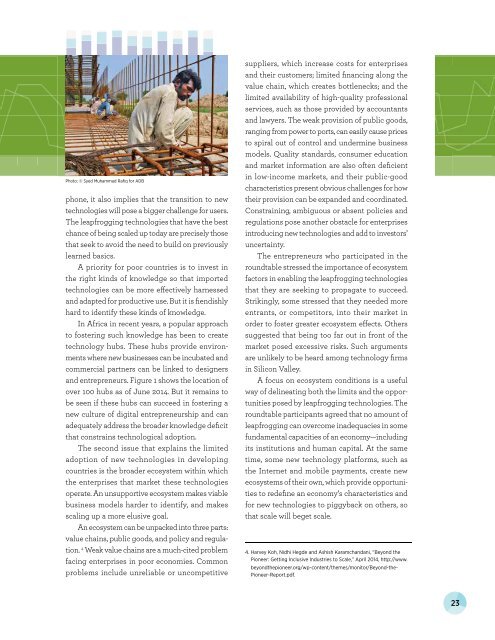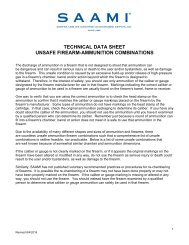Advancing Technological Diffusion in Developing Countries
Aspen14_Brookings_Blum_Roundtable_Technology
Aspen14_Brookings_Blum_Roundtable_Technology
You also want an ePaper? Increase the reach of your titles
YUMPU automatically turns print PDFs into web optimized ePapers that Google loves.
Photo: © Syed Muhammad Rafiq for ADB<br />
phone, it also implies that the transition to new<br />
technologies will pose a bigger challenge for users.<br />
The leapfrogg<strong>in</strong>g technologies that have the best<br />
chance of be<strong>in</strong>g scaled up today are precisely those<br />
that seek to avoid the need to build on previously<br />
learned basics.<br />
A priority for poor countries is to <strong>in</strong>vest <strong>in</strong><br />
the right k<strong>in</strong>ds of knowledge so that imported<br />
technologies can be more effectively harnessed<br />
and adapted for productive use. But it is fiendishly<br />
hard to identify these k<strong>in</strong>ds of knowledge.<br />
In Africa <strong>in</strong> recent years, a popular approach<br />
to foster<strong>in</strong>g such knowledge has been to create<br />
technology hubs. These hubs provide environments<br />
where new bus<strong>in</strong>esses can be <strong>in</strong>cubated and<br />
commercial partners can be l<strong>in</strong>ked to designers<br />
and entrepreneurs. Figure 1 shows the location of<br />
over 100 hubs as of June 2014. But it rema<strong>in</strong>s to<br />
be seen if these hubs can succeed <strong>in</strong> foster<strong>in</strong>g a<br />
new culture of digital entrepreneurship and can<br />
adequately address the broader knowledge deficit<br />
that constra<strong>in</strong>s technological adoption.<br />
The second issue that expla<strong>in</strong>s the limited<br />
adoption of new technologies <strong>in</strong> develop<strong>in</strong>g<br />
countries is the broader ecosystem with<strong>in</strong> which<br />
the enterprises that market these technologies<br />
operate. An unsupportive ecosystem makes viable<br />
bus<strong>in</strong>ess models harder to identify, and makes<br />
scal<strong>in</strong>g up a more elusive goal.<br />
An ecosystem can be unpacked <strong>in</strong>to three parts:<br />
value cha<strong>in</strong>s, public goods, and policy and regulation.<br />
4 Weak value cha<strong>in</strong>s are a much-cited problem<br />
fac<strong>in</strong>g enterprises <strong>in</strong> poor economies. Common<br />
problems <strong>in</strong>clude unreliable or uncompetitive<br />
suppliers, which <strong>in</strong>crease costs for enterprises<br />
and their customers; limited f<strong>in</strong>anc<strong>in</strong>g along the<br />
value cha<strong>in</strong>, which creates bottlenecks; and the<br />
limited availability of high-quality professional<br />
services, such as those provided by accountants<br />
and lawyers. The weak provision of public goods,<br />
rang<strong>in</strong>g from power to ports, can easily cause prices<br />
to spiral out of control and underm<strong>in</strong>e bus<strong>in</strong>ess<br />
models. Quality standards, consumer education<br />
and market <strong>in</strong>formation are also often deficient<br />
<strong>in</strong> low-<strong>in</strong>come markets, and their public-good<br />
characteristics present obvious challenges for how<br />
their provision can be expanded and coord<strong>in</strong>ated.<br />
Constra<strong>in</strong><strong>in</strong>g, ambiguous or absent policies and<br />
regulations pose another obstacle for enterprises<br />
<strong>in</strong>troduc<strong>in</strong>g new technologies and add to <strong>in</strong>vestors’<br />
uncerta<strong>in</strong>ty.<br />
The entrepreneurs who participated <strong>in</strong> the<br />
roundtable stressed the importance of ecosystem<br />
factors <strong>in</strong> enabl<strong>in</strong>g the leapfrogg<strong>in</strong>g technologies<br />
that they are seek<strong>in</strong>g to propagate to succeed.<br />
Strik<strong>in</strong>gly, some stressed that they needed more<br />
entrants, or competitors, <strong>in</strong>to their market <strong>in</strong><br />
order to foster greater ecosystem effects. Others<br />
suggested that be<strong>in</strong>g too far out <strong>in</strong> front of the<br />
market posed excessive risks. Such arguments<br />
are unlikely to be heard among technology firms<br />
<strong>in</strong> Silicon Valley.<br />
A focus on ecosystem conditions is a useful<br />
way of del<strong>in</strong>eat<strong>in</strong>g both the limits and the opportunities<br />
posed by leapfrogg<strong>in</strong>g technologies. The<br />
roundtable participants agreed that no amount of<br />
leapfrogg<strong>in</strong>g can overcome <strong>in</strong>adequacies <strong>in</strong> some<br />
fundamental capacities of an economy—<strong>in</strong>clud<strong>in</strong>g<br />
its <strong>in</strong>stitutions and human capital. At the same<br />
time, some new technology platforms, such as<br />
the Internet and mobile payments, create new<br />
ecosystems of their own, which provide opportunities<br />
to redef<strong>in</strong>e an economy’s characteristics and<br />
for new technologies to piggyback on others, so<br />
that scale will beget scale.<br />
4. Harvey Koh, Nidhi Hegde and Ashish Karamchandani, “Beyond the<br />
Pioneer: Gett<strong>in</strong>g Inclusive Industries to Scale,” April 2014, http://www.<br />
beyondthepioneer.org/wp-content/themes/monitor/Beyond-the-<br />
Pioneer-Report.pdf.<br />
23






